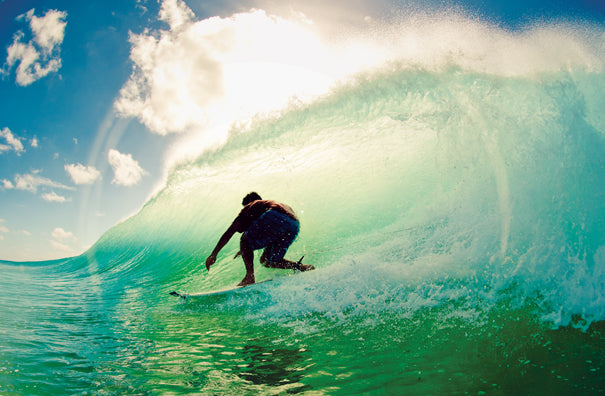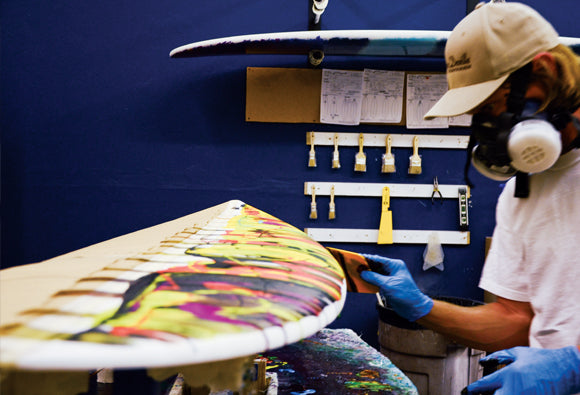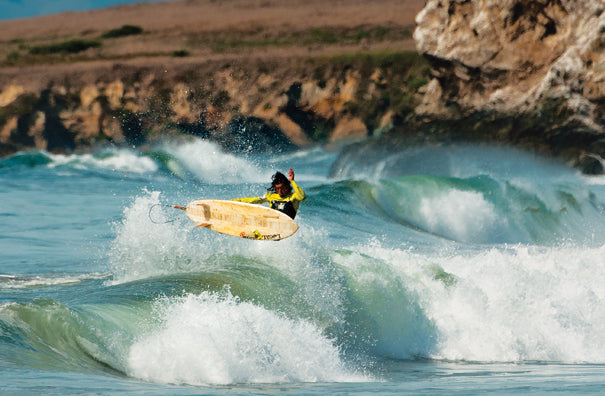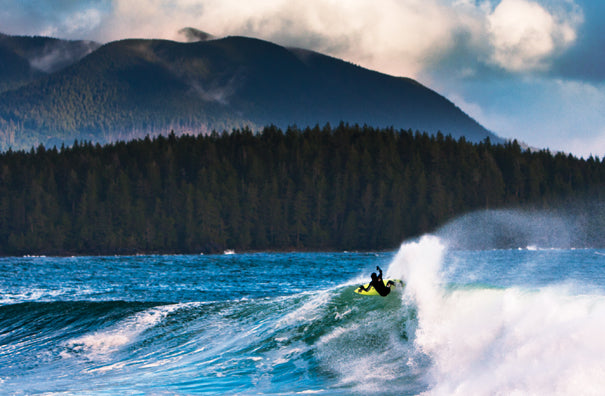Bio Surfboard Resin vs Poly Surfboard Resin
Bio Resin

![]() You know its good when you break the nose of your surfboard and still don’t go in. Zander Morton, in a Caribbean trance.
You know its good when you break the nose of your surfboard and still don’t go in. Zander Morton, in a Caribbean trance.
The Polynesians - The Inventors
You can’t surf a foam blank. Modern surfboards are fragile at their core and require a protective shell to shield them against the harsh physical abuse of surfing. Simply put, a surfboard would not be a surfboard without resin and fiberglass—unless, of course, it was made from wood or plastic.
Most believe that the early Polynesians invented surfing and brought the sport to Hawaii. I personally believe it was the Norwegian Vikings, not the Hawaiians, who were the first surfers. You can’t tell me that those Norsemen didn’t try to surf at some point while traversing the coasts of Europe, Asia and the North Atlantic islands.
The Vikings were hardcore, and I bet they were also the original tow-in crews, using their seagoing clinker-build vessels to pull in fellow Vikes into those hidden Scandinavian pits. Did you know the word “knarr” is the Norse term for ships that were built for Atlantic voyages?
I’d venture to suggest that the word “knarrly” or “gnarly” had its roots in the early Viking lexicon and is further proof of this theory. Anyway, let’s get back to the Hawaiians.
Bob Simmons
Those early Hawaiian boards were made of wood. In 1949 Bob Simmons designed and built the first styrofoam core boards, using plywood veneers and sealed with resin.
Then in 1958 Hobie Alter took that original Bob Simmons design one step further, producing boards with polyurethane foam cores while utilizing fiberglassing techniques using polyester resins to form the outer shell of the surfboard.
That brings us to the point of this article, historically speaking at least. Most surfboards have three resin layers that cover the foam core; the laminate coat, the hot coat, and lastly, the gloss coat. The majority of surfboards today are built with polyester resin and fiberglass cloth.

![]() Glassers at FCD Surfboards working on the last stages of multiple boards at once.
Glassers at FCD Surfboards working on the last stages of multiple boards at once.
Polyester Resin & VOCs
Wikipedia defines polyester resin as “unsaturated resins formed by the reaction of dibasic organic acids and polyhydric alcohols.”
Polyester resin is the cheapest resin available in the industry and yet offers the poorest adhesion, has the highest water absorption, highest shrinkage, and releases a high level of volatile organic compounds or VOCs. (This article is sounding like a chemistry class.)
VOCs are organic chemicals that have a high vapor pressure at room-temperature conditions. Ever walked into a glasser’s shop or repaired your board at home? That smell is your evidence of VOCs; don’t breathe in too deeply.
It’s the VOCs that you need to watch out for. High exposure to VOCs is not a good thing and can cause all kinds of health issues and environmental problems.
I don’t support the doom and gloom approach, but long-term exposure to VOCs can lead to gnarly illnesses, like cancer.

![]() Nick Cooper of Coop Deville Surfboards glasses many of his EPS epoxy boards with a resin tint.
Nick Cooper of Coop Deville Surfboards glasses many of his EPS epoxy boards with a resin tint.
Epoxy Resin
Epoxy. The word alone sounds a little sexy, and when you hear it you should pay attention because it’s a better alternative to polyester resin.
Epoxy is high-strength glue that is far superior to the majority of paste glues available on the market. Its full name is polyepoxide as it is formed by the reaction of polyamine and epoxide.
The epoxide is the resin base of the reaction, while the polyamine is the hardening substance. When combined, these compounds bond together on a chemical level in a criss-crossed fashion that makes the resulting substance strong.
This reaction takes some time to develop and is normally called the curing of the resin. Depending on how thinly the two substances are poured, and the mix of hardeners and resins, the curing time can vary. In some cases, heat can be applied to speed up the drying time, but normally it is cured only with time.
Epoxy is lighter, stronger and emits significantly less VOCs than polyester.
Sounds good, right?
Epoxy also allows for more flex strength than polyester, which means that your board can withstand greater punishment from the lip. The thing is, epoxy resin is more expensive than polyester and tougher to work with, so the masses gravitate toward the cheaper and easier alternative.

![]() Gerry Lopez and Fletcher Chouinard collaborating in the shaping bay.
Gerry Lopez and Fletcher Chouinard collaborating in the shaping bay.
Poly vs Epoxy vs Bio
So what’s better than epoxy resin? Bio-based resin, the ecological alternative. Oddly enough bio resins have been around for several decades and have gone pretty much unnoticed except by those few people unable to tolerate the smell of commonly used petroleum-based resins or the random experimental hippie.
Well, it’s safe to say those days are over now, and pretty much everyone has become a guardian to the environment in one way or another. I ventured out and asked a few resin gurus about bio resin, and they came back with some interesting nuggets of eco-knowledge.
First to respond was Tony Gowen from Phix Doctor. I have known Gowen for a few years now because Wave Tribe distributes his eco ding repair kit, something I have used myself and highly recommend.
According to Gowen, using bio resin has environmental advantages because
“bio-based resin is sourced from plants, a renewable resource that reduces the need for petroleum in the manufacturing process. The Phix Doctor formula is free of toxic compounds and emits nearly zero carbon particles during the curing process.”
I like the idea of nearly zero VOCs, which made me wonder about other bio-based resin.

![]() Chad Jackson of Kaimanu Surfboards has started shaping his own Bamboo boards using bio resin.
Chad Jackson of Kaimanu Surfboards has started shaping his own Bamboo boards using bio resin.
Founder of Entropy Resin Shares Some Knowledge
I called Desi Benatao over at Entrophy resins and found out their bio resins are an epoxy-based polymer that is partially derived from pine trees and vegetable oils. When asked about the environmental advantages of bio resin, Benatao answered,
“we’ve really tried to break this down so that in the end consumers can understand it, and in our minds, the one environmental issue we can all relate to is global warming. We’ve done an extensive study using life cycle analysis models and the key figure from that work is that our resins have about 50 percent of the carbon footprint of conventional petroleum derived resins. Using this data we are in the process of getting third party certification for carbon footprint savings as well as environmental preferability.”
So, what I learned after talking with these guys is that bio resins are really a more refined epoxy resin that is derived either from all plant sources and/or a combination of plant and other sources thus decreasing our reliance on petroleum based compounds.
That’s a win-win for everyone.
But the thing that I thought was even more important, especially to us surfers, is that zero or near to zero VOCs are emitted while using the bio product.
Having a lower carbon footprint is good and all, but being able to repair my boards without frying my brain is what I am most interested in, and I know you are too.
The reality is that it’s hard to be green and still get what we want at the price that we are comfortable with. I don’t see any of the pros talking about bio resin or promoting how green their boards are.
I googled green surfboards and couldn’t find any credible surfboard shapers pushing bio resin or green boards.
Great respect goes out to Fletcher Chouinard for pushing green innovations in his board-building art. He obviously has different DNA than the rest of us, which is evident in his business model of “causing no unnecessary harm.”

With the majority of boards now being built in China and Thailand by non-surfers operating under low or no regulatory guidelines, the likelihood of the industry moving towards bio resin doesn’t seem plausible.
Yet, every small step toward a greener lifestyle is a positive expression of a cleaner and healthier future (check out this NASA video if you still think global warming is a myth: http://ow.ly/8EEZB).
Three Things you Can Do Today
You are probably wondering what you can do?
- I’ve got some ideas. If you are going to buy a ding repair kit, consider bio alternative.
- Buy your boards from local shapers, and request that they use epoxy to glass your next board, or go a step further and ask for bio resin.
- Support local surfboard shapers like Chouinard or buy your materials from suppliers who use greener materials, and educate your friends on the subject.
Put your wallet to work, that is how real change takes place.
I wonder what the ocean looked like back in the day of the Polynesians and Vikings, before our plastic and petroleum-based society?
I can’t imagine any Viking rolling up to something like Trash Island in the Pacific or observing early Hawaiians throwing garbage into the lineup at Pipe.
The oceans must have been emerald paradises back then in the Norsemen’s era, as clear and clean as a windless morning barrel in Fiji. I hope that one day, we, as a tribe of surfers, are able to help revive our ocean’s health while living in a responsible and conscientious way on land.
Wherever you can, please consider choosing the eco-alternative—it’s completely up to you.

